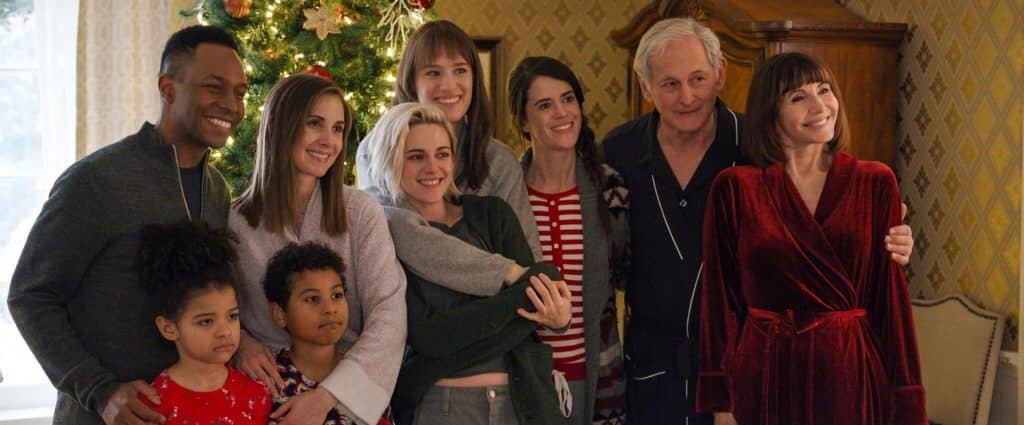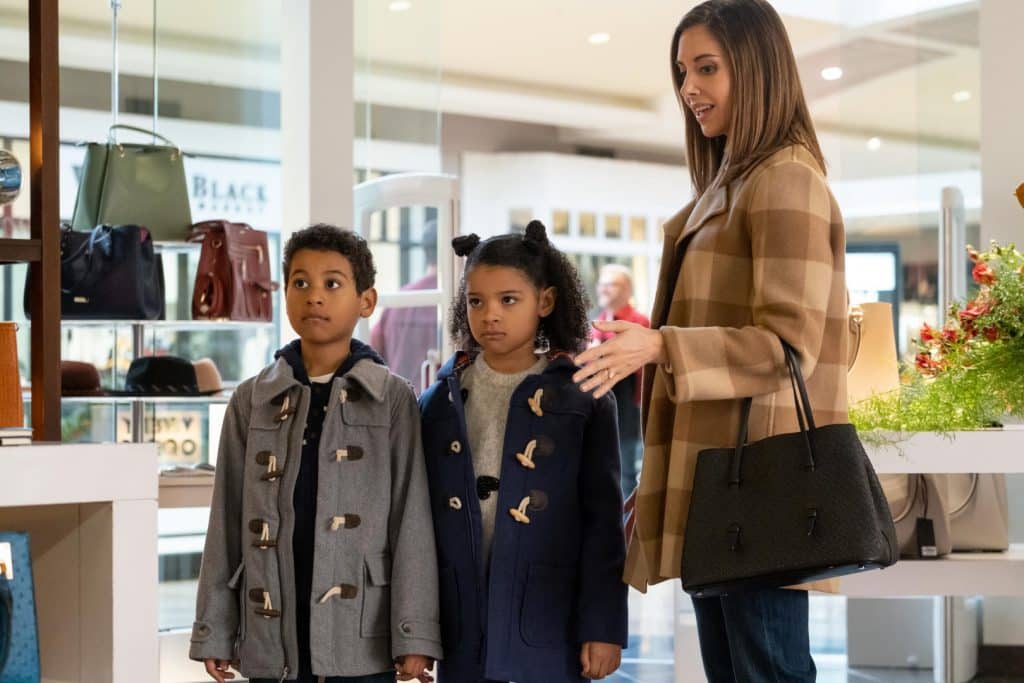Clea DuVall’s queer holiday rom-com makes the yuletide gay, but can’t escape the blind spots of its wealthy, white characters.
2020 was a great year for lesbians in film. The releases and long-term love for films like Ammonite and Portrait of a Lady on Fire point to a gap in the industry that had previously been ignored. I don’t want to inundate this larger conversation on representation with any more discourse on lesbian period dramas or the like, because Happiest Season, Hulu’s holiday release starring Kristen Stewart and directed by Clea DuVall, actually posits itself as a breath of fresh air. It’s a film that approaches the hard-to-acknowledge queer aversion to the holiday season: the troubles with coming out, constructing a chosen family, then coming back for the holidays to a home that may not know, see, or respect the real you.
But there’s something to say about how lackadaisical we get in our celebrations of films like this — while representation is important, there’s always work to do, and Happiest Season is no exception.
The plot is realistic enough: Harper (Mackenzie Davis), a young, white urban professional, brings her girlfriend Abby (Stewart) home to her WASPy family in the suburbs for Christmas. But just as they’re about to reach her childhood home, Harper reveals to Abby that she’s not out of the closet at home — to her family, Abby is just her orphaned roommate that she offered to come celebrate with her.

It’s a terrifying scenario; I’ve spent nights and holidays myself in my own hometown hoping to return to my queer safe spaces and having to play straight. Being closeted to immediate family but living an entirely open, lesbian life outside of that is exhausting, but relatable to many people. Not only are LGBTQ+ people more likely to face depression and anxiety year-round than other groups, but that the stigma around, and rejection towards, our identities makes it worse.
But the life that Harper leads is anything but representative of this. The car pulls into her large estate home, where we’re introduced to her father (Victor Garber), who’s running for local office, and her mother (Mary Steenburgen) and her perfectly coiffed bob dashing around the house to keep up her family’s public appearance. Indications of their class standing seep throughout the film, from their large, palatial home to her parents’ concerns being about maintaining an appearance as the perfect family fit for political office. Harper’s parents’ express disdain towards her sister Sloane (Alison Brie) leaving her career and Yale law degree for a different, equally profitable business endeavor. Even the scenes of the family schmoozing at a black-tie holiday event are more tailored to furthering her father’s political credibility than genuine familial gatherings.
As a Black lesbian, the fear I felt for Harper dissipates the more we peek behind the curtain of her wealthy white world. She has lived comfortably in the arms of wealthy parents. She and her sisters’ biggest gripes are that they don’t get to be themselves in totality, due to their parents’ expectations. There’s no threat of violence, ostracization or potential homelessness of the kind many lesbians of color fear upon coming out. Simply put, Harper’s situation is hardly the high-stakes dilemma faced by many more vulnerable queer people. The most she has to fear is disappointing her parents; for many queer people, especially lesbians of color, the stakes are life or death.
Simply put, Harper’s situation is hardly the high-stakes dilemma faced by many more vulnerable queer people.
Abby and Harper have to hide their love from Harper’s family and her small town, but the film plays these scenes for laughs — reminders that she’s vastly more safe and secure than a majority of the queer community. Lesbians of color, let alone Black lesbians, don’t get the same platform to create and garner attention for films that would allow them to depict their lesbianism and the struggle of coming out without pain or violence. Admittedly, this movie is a romantic comedy—a rarity in the queer cinema canon that typically plays on pain for the major plot—much of the time, enacting senseless and tiring violence against queer people. Harper’s struggle with coming out and battling compulsory heterosexaulity at home is something many lesbians have experienced, especially when visiting their childhood home. But using this internal struggle as the crux of the wacky humor whitewashes the lesbian experience, making it seem that for lesbians of color, our coming out will be nothing but the polar opposite.
In Happiest Season, coming out is the punchline; Harper’s final last stand of having to come out or lose her girlfriend are as low-stakes as they get. They sneak into each other’s rooms to steal a kiss, Harper hides silently behind Abby’s door as Harper’s mother bursts in looking for Christmas decorations. What’s typically a terrifying scene for more vulnerable queer people turns, in this safe white space, into humor.
The unrelenting whiteness of this particular Christmas comes in stark relief when you come to the characters of color, who are so rare I can count them on one hand. Three of them are tertiary relatives to the Harper nuclear family: Sloane’s husband, Eric (Burl Moseley), and their twin children all demonstrate distinctly “deviant” characteristics to the backdrop of the very white, conservative family at its center. For most of the film, we only meet Eric in passing conversations with Sloane; his final close-up comes when Sloane finds him in the closet with another woman. Suddenly, the relatively-stable Black husband becomes a cheater with which Sloane has an “arrangement” due to their impending divorce.

Their two children are reduced to mischievous troublemakers who not only catch Harper in Abby’s room, thus making them accomplices to the lie, but frame Abby for shoplifting in the mall for no other reason than pure malice. It would be remiss to ignore the characterization of the few Black characters in the cast in juxtaposition to the rest of the family, whom DuVall and co-writer Mary Holland paint as kooky at best and dysfunctional at worst.
Some may argue that, since lesbian films are chock-a-block with drama and disaster, a cheery holiday film is what we all deserve. But to dismiss Happiest Season as an all-encompassing example of lesbian representation is disheartening, to say the least. There are plenty of us who don’t find joy in watching another white member of the LGBTQ+ community falling back on the comfort of whiteness and class. Harper’s biggest problem, as she essentially puts it in the climactic scene of the film, is that being gay just wouldn’t fit the family image.
I genuinely tried to find myself in Happiest Season, with excitement for more opportunities for representation. But that amounts to little more than empty buzzwords if DuVall fails to recognize its own misgivings. Its depiction of queerness is intersects deeply with whiteness and class in a way that’s unsatisfying, especially when it treats the Black characters as plot foils and nothing more.
There will never be a film that does everything right and is wholly representative of all lesbians and other members of the community. But for all of Happiest Season’s rightful praise as a work of queer representation, there’s still a long way to go in addressing the other shades of the queer experience. The future of joyful, queer holiday cinema should at least make an effort to acknowledge how difficult it is to be in the shoes of the token queer family member. If we go by the few films that actually feature and celebrate us, you can only be happy and queer if you’re also rich and white.